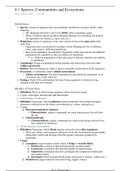Study guide
IB HL Biology Unit 4 Ecology Notes
- Course
- IB HL Biology
- Institution
- Bayview Secondary School
IB Higher Level (HL) Biology notes from unit 4 - Ecology. I achieved a level 7 in this course using these high-yield, in-depth notes. They include course content from the Oxford IB HL Biology textbook, Cambridge HL Biology textbook, Bioninja and the classroom. These notes go well in-depth into the...
[Show more]



